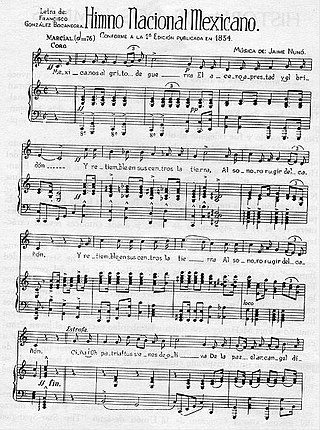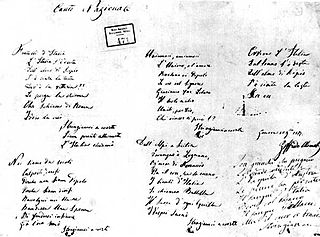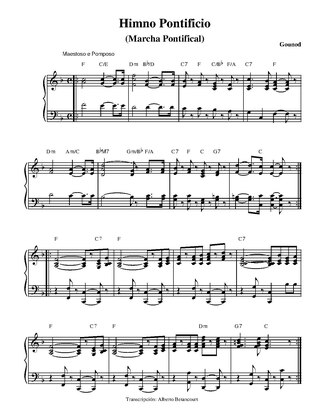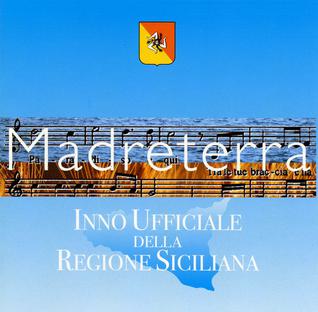An anthem is a musical composition of celebration, usually used as a symbol for a distinct group, particularly the national anthems of countries. Originally, and in music theory and religious contexts, it also refers more particularly to short sacred choral work and still more particularly to a specific form of liturgical music. In this sense, its use began ca. 1550 in English-speaking churches; it uses English language words, in contrast to the originally Roman Catholic 'motet' which sets a Latin text.

Mazurek Dąbrowskiego, in English officially known by its incipit Poland Is Not Yet Lost, is the national anthem of the Republic of Poland.

The "Mexican National Anthem", also known by its incipit "Mexicans, at the cry of war", is the national anthem of Mexico. The anthem was first used in 1854. The lyrics of the national anthem, which allude to historical Mexican military victories in the heat of battle and including cries of defending the homeland, were composed by poet Francisco González Bocanegra after a Federal contest in 1853. Later, in 1854, he asked Jaime Nunó to compose the music that now accompanies González's poem. The national anthem, consisting of ten stanzas and a chorus, effectively entered into use on September 16, 1854.

"Il Canto degli Italiani" is a canto written by Goffredo Mameli set to music by Michele Novaro in 1847, and is the current national anthem of Italy. It is best known among Italians as the "Inno di Mameli", after the author of the lyrics, or "Fratelli d'Italia", from its opening line. The piece, in a time signature of 4/4 and the key of B-flat major, consists of six strophes, and a refrain sung at the end of each strophe. The sixth group of verses, which is almost never performed, recalls the text of the first strophe.
A national anthem is a patriotic musical composition symbolizing and evoking eulogies of the history and traditions of a country or nation. The majority of national anthems are marches or hymns in style. American, Central Asian, and European nations tend towards more ornate and operatic pieces, while those in the Middle East, Oceania, Africa, and the Caribbean use a more simplistic fanfare. Some countries that are devolved into multiple constituent states have their own official musical compositions for them ; their constituencies' songs are sometimes referred to as national anthems even though they are not sovereign states.

The "Swiss Psalm" is the national anthem of Switzerland.

The "Pontifical Anthem and March", also known as the "Papal Anthem", is the anthem played to mark the presence of the Pope or one of his representatives, such as a nuncio, and on other solemn occasions. When the Vatican's flag is ceremonially raised, only the first eight bars are played.
"Mer Hayreniḱ" is the national anthem of Armenia. It was arranged by Barsegh Kanachyan; the lyrics were written by Mikayel Nalbandian. First adopted in 1918 as the anthem of the short-lived First Republic of Armenia, it was subsequently banned after the country was invaded by then incorporated into the Soviet Union. Following the dissolution of the Soviet Union and the restoration of sovereignty in 1991, the song was re-adopted as the national anthem, albeit with slightly modified lyrics.

The "Himno Nacional de Uruguay", also known by its incipit "Orientales, la Patria o la Tumba", is the longest national anthem in terms of duration with 105 bars of music. When performed in its entirety, the anthem lasts about four-and-a-half to six minutes, although nowadays only the first verse and chorus are sung on most occasions, such as before sporting events.

Jaime Nunó Roca was a Spanish composer from Catalonia who composed the music for the Mexican national anthem.

Greasers are a youth subculture that emerged in the 1950s and early 1960s from predominantly working class and lower-class teenagers and young adults in the United States. The subculture remained prominent into the mid-1960s and was particularly embraced by certain ethnic groups in urban areas, particularly Italian Americans and Latino Americans.
San Marino is a small sovereign state located within the territory of Italy. It has a musical heritage which includes the 17th-century composer Francesco Maria Marini di Pesaro and the 20th-century composer Cesare Franchini Tassini (1925–2010).

Mauro Germán Camoranesi Serra is an Italian football manager and former player who played as a right midfielder or right winger.
The Marcia Reale d'Ordinanza or Fanfara Reale was the official national anthem of the Kingdom of Italy between 1861 and 1946. It was composed in 1831 by Giuseppe Gabetti to the order of Charles Albert of Sardinia as the hymn of the royal House of Savoy, along with the Sardinian national anthem. It remained a famous, recognizable and cherished symbol of Italy throughout the history of the Monarchy.

The national flag of Mexico is a vertical tricolor of green, white, and red with the national coat of arms charged in the center of the white stripe. While the meaning of the colors has changed over time, these three colors were adopted by Mexico following independence from Spain during the country's War of Independence, and subsequent First Mexican Empire.

The Marcia trionfale was the first personal anthem of the Pope and state anthem of the Vatican City State. It was written in 1857 by Viktorin Hallmayer, then director of the band of the Austrian 47th Infantry Regiment of the Line stationed within the Papal States.
Bárbara Padilla is a Mexican-American operatic soprano. She was the runner-up on the fourth season of America's Got Talent. She is well known as a survivor of Hodgkin's lymphoma.

"Madreterra" is the official anthem of Sicily since 2003. It was the first regional anthem in Italy, and was written by Vincenzo Spampinato, who was chosen after an official competition. However, other songs have been traditionally regarded as national anthems of Sicily. The lyrics are in Italian. Madreterra was performed in public for the first time at the Ancient theatre of Taormina on 14 June 2003 by the Sicilian Symphony Orchestra and the Musa 2000 Choir.
The Anthem of Yucatán was officially adopted on September 15, 1867. The lyrics of the state anthem were composed by Manuel Palomeque and the music composed by Jacinto Cuevas. The Anthem of Yucatán was the first state anthem in Mexico. During almost all the 20th century, the anthem was sung in schools.

S'hymnu sardu nationale, also known by its incipit as Cunservet Deus su Re, was the national anthem of the Kingdom of Sardinia under Savoyard rule and of the Kingdom of Italy.












